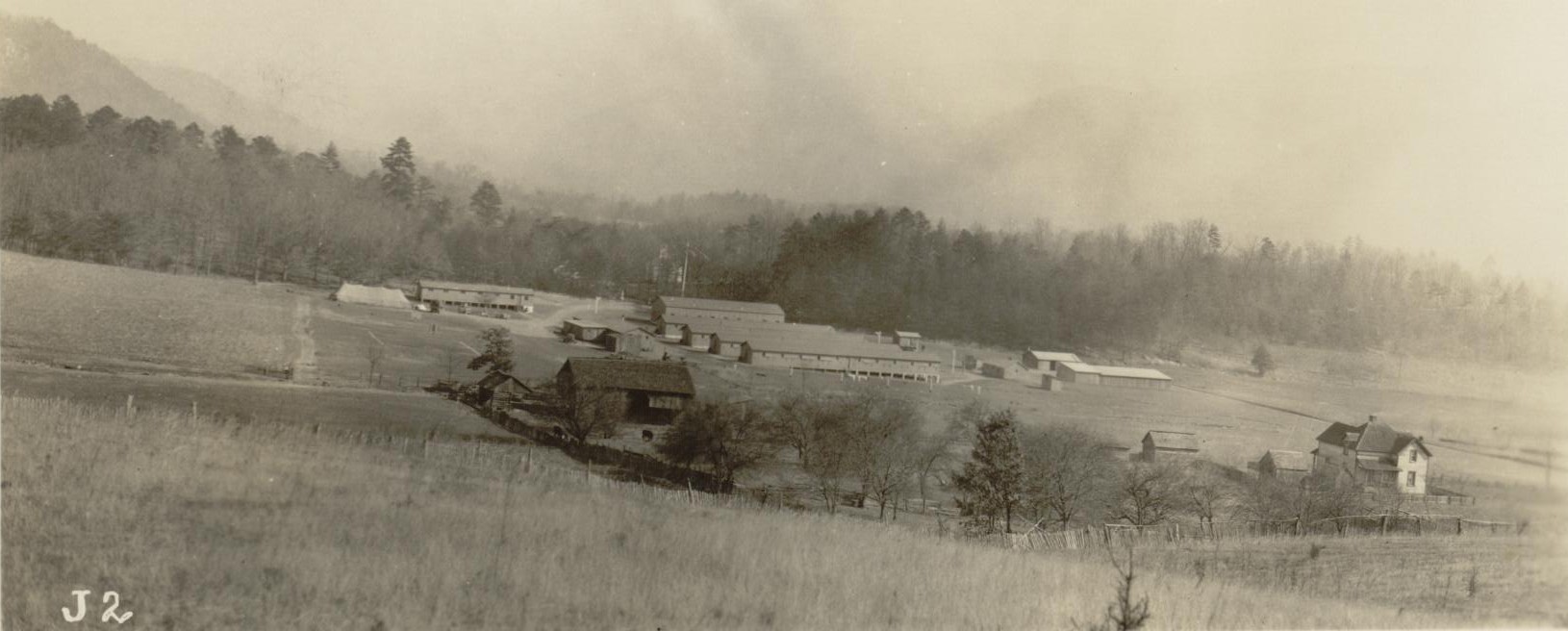Cades Cove Civilian Conservation Corps Camp Site Project by Dave Post
The barracks, other buildings and features associated with the former Cades Cove Civilian Conservation Corps (CCC) Camp are but a memory to those who either were associated with the enterprise or who were of age to have visited in the period of activity in the 1930s. However, the accomplishments of those who found employment there during the Depression years remain to be appreciated by visitors. After the camp dissolved, many of the structures found utility among those who possessed agricultural leases in the Cove.
These included Kermit Caughron who converted a CCC Camp building into his “honey shed” and the Sparks family whose “hog shed” was a former CCC structure. The Caughron honey shed was removed along with other buildings by the GSMNP in 2002. Leon and Jonnie Sparks recall that, after the bear population of the Cove developed a taste for pork, the Sparks family abandoned raising hogs. Their hog shed was converted into a residence for Leon and Jonnie’s family during their early years of married bliss in the Cove. Other CCC buildings were removed from the Cove or were demolished and lumber salvaged for use by lessees and others.
Only a few features of the Cades Cove CCC Camp site are distinguishable today. In the spring, one can observe the last CCC Camp Identification Number “5427” displayed in the upper meadow by blooming buttercups (the original camp number was “1214”). It is doubtful that the young men who planted those buttercups many years ago appreciated that the results of that labor would survive. The CCC boys also built a concrete dam on Tater Branch a few hundred yards upstream from the main camp site which remains in place today, albeit now filled with rocks and sand. This apparently served as a swimming pool and may have been associated with the camp water supply. Remnants of piping from the general area of the dam can be detected along the banks of Tater Branch. The workers also landscaped with flower beds, and perhaps pools, using stones from the area. One such feature remains at the corner of the camp site property adjacent to the Loop road and diagonally opposite the Missionary Baptist Church in the form of a circle of stones, approximately eight inches in height with a diameter of eight to ten feet.
The stone circle, legacy of a former flower bed, pool or flag location, had become visibly obscure, particularly during the warmer months, due to unobstructed growth of grasses, briars, and trees. As the CCPA considers the existence and accomplishments of the Cades Cove CCC Camp a significant portion of Cades Cove cultural history, the stone circle was targeted as one feature which could provide a visible camp signature. Our liaison in Cades Cove with the GSMNP, Dale Brukiewa, was approached this spring with a request and proposal to improve visibility of the feature through CCPA efforts. Dale followed up with review of the proposal with appropriate GSMNP offices and provided approval to the CCPA in June. Dale also visited the project location with the CCPA, communicated project criteria in July and indicated support would be provided by his staff in Cades Cove.
On Saturday, July 22, a team of CCPA workers joined with Cades Cove GSMNP staff to execute the CCC Camp project. As the Loop Road was restricted to recreational users in the early morning hours, authorization and escort was provided for a 7:30 a.m. entry to transport equipment and enable an early start for the work. The weather was also cooperative as much needed rain the day and night before had cooled the air making working conditions much more tolerable. Those who arrived at the project site “in the wee morning hours” were Paulette and David Ledbetter, Missy Tipton and Dave Post. CCPA workers were joined by Dale Brukiewa and Larry Carter, a Hot Springs, North Carolina native on Dale’s staff. Larry, Dale and others, during the preceding week, had visited the work site to remove a few objectionable trees which both obscured the visibility and were a roadside attraction for bears. The CCPA workers were armed with wheel barrows, rakes, mattocks, shovels, weed eaters, a lawn mower, fluids and baloney. Posters and photographs of the former camp were also exhibited to educate curious visitors and to promote interpretation and debate among the work crew.
“What have we got ourselves into now!” was an immediate sentiment for the crew. The vegetation was four to five feet tall in the vicinity of the stone circle necessitating an initial search to even locate the feature. The removal effort was certainly worthy of more robust equipment than weed eaters and a push mower! Nevertheless, after locating the feature, an access path was mowed to the stone circle and a work area slowly carved around the periphery. Weed eaters then gradually reduced the height of the vegetation on the interior to a level which enabled use of the mower. After establishing an absence of poisonous reptiles and stinging insects, the male workers were joined by the females! The work then began in earnest with vegetation slowly disappearing, being replaced with perspiration and restored enthusiasm. After several hours, the majority of vegetation was removed to the vicinity of the Loop Road, a distance of twenty to thirty feet, and the grass roots dug from the interior of the stone circle. The sole reported casualty during this period was Ms. Tipton, who after demanding the opportunity to operate the mower, proceeded to arouse the ire of a family of yellow jackets. This circumstance became apparent to her co-workers because of her verbal and physical responses! After administering first aid to Missy, removal of the mower left directly above the insects’ home, and chemical elimination of the hazard, work continued, albeit very cautiously, and without Dale who had retreated to the safety of his truck due to a strong allergy to insect venom and perhaps a preference for air conditioning otherwise.
After 10:00 a.m., the early morning crew was reinforced by the arrival of Roy Coada and Jim Butterfield. Their arrival was appreciated by the bedraggled workforce! The expanded crew then initiated placement of a plastic barrier on the interior of the stone circle and the transport of chat from the vicinity of the Missionary Baptist Church. After pausing to enjoy lunch, placement of chat on the interior and exterior of the circle and removal of vegetation around stumps and along the roadway was completed. Litter, including rusted barbed wire, bottles and cans, was collected and removed. Around 1:00 p.m., the work was concluded and the crew retreated to the shade where the beauty of Cades Cove and the satisfaction of accomplishment were enjoyed by all. A few visitors stopped by, including Mike Mazlona, the Resource Education Officer for Cades Cove. Mike was encouraged to research placement of signage to designate the site as the former location of the Cades Cove CCC Camp.
The CCPA is very appreciative of the efforts of Dale Brukiewa to secure approval for the project and for his personal and staff efforts to contribute to the work. We are particularly grateful for the participation of Larry Carter who proved to be a capable and supportive worker, remaining with us throughout the day and really pulling his load! The GSMNP is fortunate to have folks like Dale and Larry on staff. The CCPA is also!
The area immediately surrounding the stone circle will be maintained by the Cades Cove GSMNP staff. The feature will exist as a visible signature of the contributions and location of the Cades Cove CCC Camp.
Added Note:
Dave Post and Dwight McCarter have made an initial attempt to locate the site of the Laurel Creek CCC Camp which is east of Crib Gap near the Finley Cane Trail. This camp came to the Cove area in 1933, staying for less then a year, and was a "tent camp".




